phb2013_complete_en.pdf [18.3 MB] - Wöhner
phb2013_complete_en.pdf [18.3 MB] - Wöhner
phb2013_complete_en.pdf [18.3 MB] - Wöhner
Create successful ePaper yourself
Turn your PDF publications into a flip-book with our unique Google optimized e-Paper software.
Note on operating NH fuse switch disconnectors<br />
and NH in-line fuse switch disconnectors<br />
NH fuses are only int<strong>en</strong>ded for use by authorized electricians<br />
or trained electrical personnel, see IEC 60269-2.<br />
Wh<strong>en</strong> switching devices observe the following instructions:<br />
– Operation (release, switching on, switching off and<br />
fuse replacem<strong>en</strong>t) only permitted for authorized<br />
electricians or trained electrical personnel in accordance<br />
with VDE 0105-100.<br />
Conductor connections<br />
Specifi cations regarding conductor terminals are only valid<br />
for copper conductors. The maint<strong>en</strong>ance-free resistance<br />
to ageing for selected connections has be<strong>en</strong> verifi ed by<br />
testing.<br />
If the standards-compliant connection of aluminium<br />
conductors has be<strong>en</strong> confi rmed for connection terminals,<br />
this is stated expressly.<br />
Before connecting aluminium conductors, any oxide<br />
deposits must be removed from the conductor surfaces<br />
and further oxidation prev<strong>en</strong>ted.<br />
After removal of the oxide deposit, chips and abrasives<br />
cannot be permitted to damage the contacting.<br />
Multiwire conductors should be short<strong>en</strong>ed and exposed<br />
to the bare metallic conductor section.<br />
The contact points are to be sealed (e.g. using acid-free<br />
contact grease) so that they airtight to protect them against<br />
further oxidation.<br />
The terminal points need to be checked, taking operating<br />
conditions into account.<br />
For normal ambi<strong>en</strong>t conditions and loads, we recomm<strong>en</strong>d<br />
inspections at 6-month intervals. In case of unfavourable<br />
operating conditions or frequ<strong>en</strong>t temperature fl uctuations<br />
at the terminal points, a shorter interval may be necessary.<br />
It is possible to place temperature measuring strips and a<br />
record of the maximum values in the immediate vicinity of<br />
the terminal points, which may be useful for an objective<br />
assessm<strong>en</strong>t during regular tests.<br />
All contact positions are suitable for connecting one<br />
conductor, unless expressly otherwise indicated. Doublefunction<br />
terminals are characterised by 2 contact positions.<br />
In principle, the tight<strong>en</strong>ing torques specifi ed on the device,<br />
the installation instructions or on the Internet are to be<br />
applied. Where no limits are specifi ed, the tolerance on the<br />
tight<strong>en</strong>ing torque Md of screw and clamp connections may<br />
be a maximum of +/-20% of the nominal value.<br />
Technical specifications<br />
– Quick activation of fuse cover using the relevant operating<br />
handle.<br />
– Before switching on, care must be tak<strong>en</strong> that the<br />
fuse cover is mounted or guided exactly into the op<strong>en</strong><br />
position.<br />
– If the cover is only partially op<strong>en</strong>, the fuse links may<br />
still be <strong>en</strong>ergized. Only op<strong>en</strong> and close the cover using<br />
the handle.<br />
The relationship betwe<strong>en</strong> conductor cross-sections in mm 2<br />
and AWG / MCM sizes are subsequ<strong>en</strong>tly listed:<br />
0.75mm 2 18 AWG (0.82mm 2 )<br />
1.5mm 2 16 AWG (1.3mm 2 )<br />
2.5mm 2 14 AWG (2.1mm 2 )<br />
4mm 2 12 AWG (3.3mm 2 )<br />
6mm 2 10AWG (5.3mm 2 )<br />
10mm 2 8 AWG (8.4mm 2 )<br />
16mm 2 6 AWG (13.3mm 2 )<br />
25mm 2 4 AWG (21.2mm 2 )<br />
35mm 2 2 AWG (33.6mm 2 )<br />
50mm 2 0AWG (53.5mm 2 )<br />
70mm 2 2/0AWG (67.4mm 2 )<br />
95mm 2 3/0AWG (85.0mm 2 )<br />
120mm 2 250 MCM (127mm 2 )<br />
150mm 2 300 MCM (152mm 2 )<br />
185mm 2 350 MCM (177mm 2 )<br />
240mm 2 500 MCM (253mm 2 )<br />
300mm 2 600 MCM (304mm 2 )<br />
Conductor types are designated as follows:<br />
Abbreviation Standard name<br />
solid round sol(r) Class 1 (IEC/EN 60228)<br />
stranded round s(r) Class 2 (IEC/EN 60228)<br />
solid sectored sol(s) Class 1 (IEC/EN 60228)<br />
stranded sectored s(s) Class 2 (IEC/EN 60228)<br />
fl exible f Class 5 (IEC/EN 60228)<br />
stranded str Class B (UL 486E)<br />
The following abbreviations are also used:<br />
laminated fl exible<br />
copper busbar fl . Cu<br />
wire-<strong>en</strong>d ferrules AE<br />
Wire-<strong>en</strong>d ferrules are only permitted for applications in<br />
compliance with IEC/EN standards. Wöhner has tested the use<br />
of wire <strong>en</strong>d ferrules. This does not result in a g<strong>en</strong>eral approval<br />
for diff er<strong>en</strong>t ferrules and crimping methods. The maximum<br />
conductor cross-sections may need to be reduced.<br />
Conductors must be connected according to the requirem<strong>en</strong>ts<br />
in compliance with IEC/EN 60999-1 or -2. Conductors must be<br />
connected so as to avoid t<strong>en</strong>sile loading.<br />
8<br />
2


![phb2013_complete_en.pdf [18.3 MB] - Wöhner](https://img.yumpu.com/12655320/171/500x640/phb2013-complete-enpdf-183-mb-wahner.jpg)

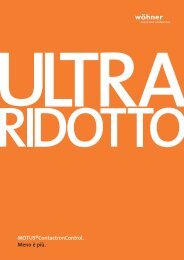
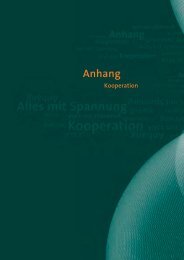
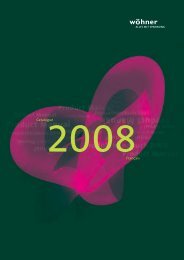

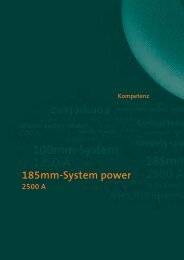
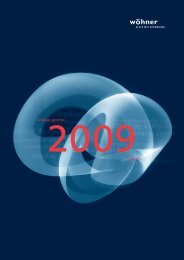
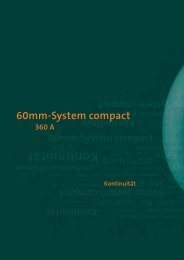

![phb2013_08_en.pdf [1.25 MB] - Wöhner](https://img.yumpu.com/12655318/1/184x260/phb2013-08-enpdf-125-mb-wahner.jpg?quality=85)
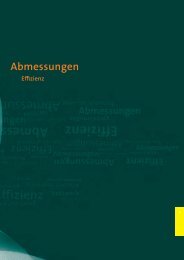
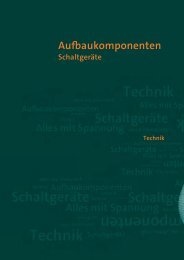

![phb2013_deu_05.pdf [4.32 MB] - Wöhner](https://img.yumpu.com/12655312/1/184x260/phb2013-deu-05pdf-432-mb-wahner.jpg?quality=85)